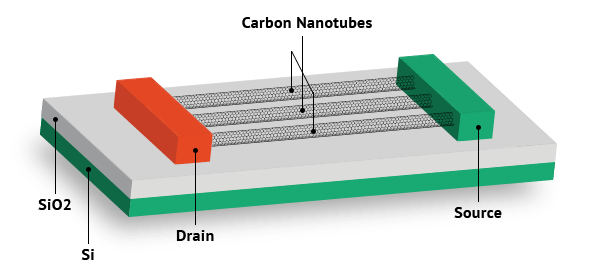مقایسه پارامترهای کلیدی نانو ترانزیستورهای اثر میدان مبتنی بر نانو لوله های کربنی با bulk MOSFET و UTS MOSFET (بر پایه دکترای نانو _ میکرو الکترونیک) (دکترای آموزشی _ پژوهشی)
پژوهشگر و نویسنده: دکتر ( افشین رشید )
نکته: تمامی نانو ترانزیستورهای روی یک ویفر بطور همزمان خاموش و روشن می شوند چون دارای گیت یکسان هستند.ضخامت لایه اکسید زیاد است واز طرفی فرآیند تولید به گونه ای است که سطح تماس نانو لوله کربنی با اکسید گیت کم بوده و برای خاموش روشن کردن قطعه با ولتاژ کم مشکل ایجاد می کند.
در ساختار نانو ترانزیستورهای گیت بالایی برای بهره بیشتر ، نانو لوله های کربنی به طور کامل درون عایق گیت قرار داده می شود.بر خلاف ترانزیستور های اثر میدان نانو لوله کربنی گیت پشتی ، می توان تعداد زیادی از این نوع ترانزیستور را روی یک ویفر ساخت ، به دلیل اینکه گیت های هر یک به صورت مجزا می باشد . همچنین با توجه به ضخامت کم دی الکتریک گیت در نانو ترانزیستور، میدان الکتریکی بزرگتری را می توان با یک ولتاژ کم روی نانو لوله کربنی ایجاد کرد . با وجود روند ساخت پیچیده تر نسبت به ترانزیستور های اثر میدان نانو لوله کربنی گیت پشتی ، مزایا فوق باعث می شوند که این نوع ترجیح داده شوند.
قرار دادن گیت در اطراف و در تمام نانولوله که باعث بهبود عملکرد می شود.ابتدا نانولوله کربنی که دارای پوشش عایق است روی ویفر قرار داده می شود که اتصال فلزی سورس و درین در دو طرف آن قرار داده می شود، سپس برای مشخص کردن و جدا کردن ناحیه سورس و درین ، si زیر نانولوله کربنی اضافه میگردد . این زدایش کردن تا رسیدن به عایق بستر ادامه پیدا می کند . سپس با استفاده از موادی که ضریب دی الکتریک بالایی دارند ، عایق بین گیت و سورس و درین ایجاد شده و همچنین فلزی روی این عایق جهت اتصال بهتر فلز گیت به نانو لوله کربنی قرار داده می شود.
نتیجه گیری:
پروسه ساخت نانو لوله ها باعث شده است که در قطر لوله ها تغییر پذیری وجود داشته باشد که معمولاً مقداری بین1 تا2 نانومتر داراست. با تغییر قطر نانو لوله شکاف باند تغییر کرده و در نتیجه ولتاژ آستانه ترانزیستور و جریان ترانزیستور تغییر می کند.
پژوهشگر و نویسنده: دکتر ( افشین رشید )




